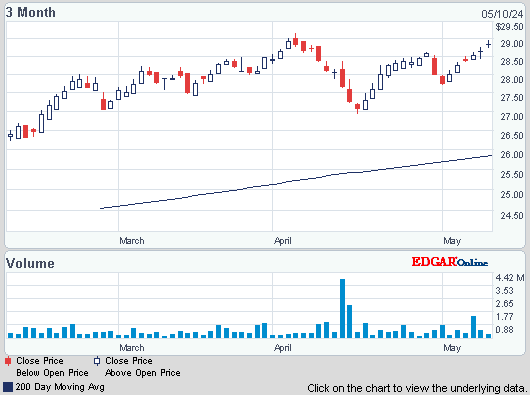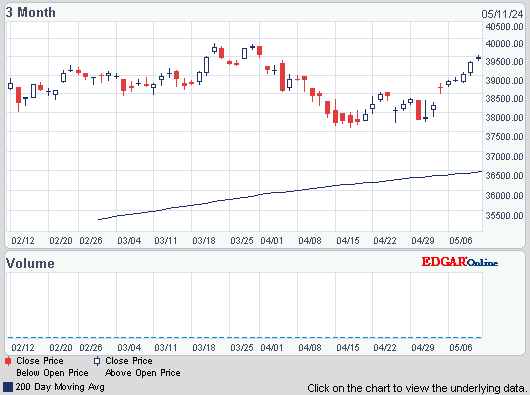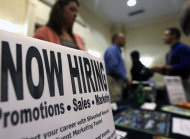Dow fell 27, decliners ahead of advancers 3-2 & NAZ lost 7. The Financial Index was down a fraction in the 216s, remaining near its yearly highs. The MLP index slipped pocket change to 405 & the REIT index rose almost 3 to the 264s, but has remained in a sideways band for months. Junk bond funds were up again & Treasuries slipped back bringing higher yields. Oil & gold took big tumbles, taking gold below $1700.

Photo: Yahoo
US employers added 171K jobs in Oct, and hiring was stronger in Aug & Sep than first thought. But the unemployment rate rose to 7.9% from 7.8% in Sep, mainly because many more people began looking for work & not all of them found jobs. Since Jul, the economy has created an average of 173K jobs a month, up from 67K a month from Apr-Jun. The work force, the number either working or looking for work, rose 578K in Oct & 410K more people said they were employed. The difference is the reason the unemployment rate rose slightly. The gov revised its data to show that 84K more jobs were added in Aug & Sep than previously estimated. Aug job gains were revised from 142K to 192K & Sep from 114K to 148K. This data remains drab.
Payrolls in U.S. Climbed More Than Forecast in October
US companies boosted their orders for manufactured goods by the largest amount in 18 months in Sep, but companies remained cautious in ordering goods that signal plans to expand & modernize. Factory orders rose 4.8% compared to Aug, a month when orders had fallen 5.1% according to the Commerce Dept. The Sep gain was the biggest since Mar 2011 & was driven by a surge in demand for commercial aircraft, a volatile category which had seen orders plunge in Aug. Demand for core capital goods, viewed as a good proxy for business investment plans, edged up a slight 0.2% following a 0.3% rise in Aug. The 2 modest gains followed 2 months of huge declines as business investment remains weak. Businesses have grown more cautious for a number of reasons. Many are concerned about the economic outlook overseas. Europe's financial crisis has pushed many countries in the region into recession which has cut into US exports & corporate profits. Growth has also slowed in China, Brazil & other big developing nations which are major markets for American exports. Companies are also hesitant to commit the money to major expansion & modernization projects without knowing whether large tax increases and big government spending cuts will take effect in Jan should Congress fail to reach a budget deal to avert them. Orders for durable goods jumped 9.8%, a slight downward revision from a preliminary report showing a 9.9% increase but still the largest in nearly 3 years. Aircraft orders skyrocketed 2650%, following a 97% drop in Aug. That's called volatile. Orders for primary metals such as steel rose 3.9% while demand for machinery was up 9.2%. Orders for nondurable goods rose 1% following a 2.2% gain in Aug. Core capital goods, the category used as a proxy for business investment, showed gains of 0.2% in Sep & 0.3% in Aug, following big declines of 5.6% in Jul & 2.7% in Jun.
In a string of meetings beginning next week, European leaders will again wrestle with how to keep Greece from running out of cash. But they almost certainly won't solve the far bigger question of how to cut down the growing pile of debt that is slowly suffocating the country. Greece must shoulder a frightful debt burden while suffering an epic recession. The euro zone now faces the prospect of dealing with its problems for years, or engineering a divorce. Greek debt will be €346B ($448B) next year, the gov said. At 189% of GDP, that debt is nearly twice what the gov thinks next year's economic output will be. The weight of debt erodes confidence in Greece's gov, its financial system & in the economy. It also scares off investment & renders ineffective recent palliative measures from the ECB, which is trying to persuade investors that stressed countries won't quit the euro zone, & so it is safe to lend to their govs & businesses. To a degree, this approach has worked for Spain & Italy. Greece will be getting more attention next week by the markets.
Fixing Greek Debt Remains Elusive Euro-Zone Target
This is a dreary day of trading with little being resolved. More attention has been on Sandy & its clean up, less on economic issues. But a sluggish worldwide economy will be more in focus next week. Dow has had a limited gain in this shortened week of trading. The approaching fiscal cliff which takes effect on Jan 1, will be taken more seriously by the markets. Not good for the bulls. Additionally, Apple (AAPL), with the largest market cap in the world, is down 113 from is Sep high when it launched the new iPhone (it's #1 product).

AMJ (Alerian MLP Index tracking fund)
Treasury yields:
U.S. 3-month |
0.091% | |
U.S. 2-year |
0.286% | |
U.S. 10-year |
1.735% |
| CLZ12.NYM | ...Crude Oil Dec 12 | ...85.81 | ..... |
| GCX12.CMX | ...Gold Nov 12 | ....1,694.00 | .... |
US employers added 171K jobs in Oct, and hiring was stronger in Aug & Sep than first thought. But the unemployment rate rose to 7.9% from 7.8% in Sep, mainly because many more people began looking for work & not all of them found jobs. Since Jul, the economy has created an average of 173K jobs a month, up from 67K a month from Apr-Jun. The work force, the number either working or looking for work, rose 578K in Oct & 410K more people said they were employed. The difference is the reason the unemployment rate rose slightly. The gov revised its data to show that 84K more jobs were added in Aug & Sep than previously estimated. Aug job gains were revised from 142K to 192K & Sep from 114K to 148K. This data remains drab.
Payrolls in U.S. Climbed More Than Forecast in October
US companies boosted their orders for manufactured goods by the largest amount in 18 months in Sep, but companies remained cautious in ordering goods that signal plans to expand & modernize. Factory orders rose 4.8% compared to Aug, a month when orders had fallen 5.1% according to the Commerce Dept. The Sep gain was the biggest since Mar 2011 & was driven by a surge in demand for commercial aircraft, a volatile category which had seen orders plunge in Aug. Demand for core capital goods, viewed as a good proxy for business investment plans, edged up a slight 0.2% following a 0.3% rise in Aug. The 2 modest gains followed 2 months of huge declines as business investment remains weak. Businesses have grown more cautious for a number of reasons. Many are concerned about the economic outlook overseas. Europe's financial crisis has pushed many countries in the region into recession which has cut into US exports & corporate profits. Growth has also slowed in China, Brazil & other big developing nations which are major markets for American exports. Companies are also hesitant to commit the money to major expansion & modernization projects without knowing whether large tax increases and big government spending cuts will take effect in Jan should Congress fail to reach a budget deal to avert them. Orders for durable goods jumped 9.8%, a slight downward revision from a preliminary report showing a 9.9% increase but still the largest in nearly 3 years. Aircraft orders skyrocketed 2650%, following a 97% drop in Aug. That's called volatile. Orders for primary metals such as steel rose 3.9% while demand for machinery was up 9.2%. Orders for nondurable goods rose 1% following a 2.2% gain in Aug. Core capital goods, the category used as a proxy for business investment, showed gains of 0.2% in Sep & 0.3% in Aug, following big declines of 5.6% in Jul & 2.7% in Jun.
In a string of meetings beginning next week, European leaders will again wrestle with how to keep Greece from running out of cash. But they almost certainly won't solve the far bigger question of how to cut down the growing pile of debt that is slowly suffocating the country. Greece must shoulder a frightful debt burden while suffering an epic recession. The euro zone now faces the prospect of dealing with its problems for years, or engineering a divorce. Greek debt will be €346B ($448B) next year, the gov said. At 189% of GDP, that debt is nearly twice what the gov thinks next year's economic output will be. The weight of debt erodes confidence in Greece's gov, its financial system & in the economy. It also scares off investment & renders ineffective recent palliative measures from the ECB, which is trying to persuade investors that stressed countries won't quit the euro zone, & so it is safe to lend to their govs & businesses. To a degree, this approach has worked for Spain & Italy. Greece will be getting more attention next week by the markets.
Fixing Greek Debt Remains Elusive Euro-Zone Target
This is a dreary day of trading with little being resolved. More attention has been on Sandy & its clean up, less on economic issues. But a sluggish worldwide economy will be more in focus next week. Dow has had a limited gain in this shortened week of trading. The approaching fiscal cliff which takes effect on Jan 1, will be taken more seriously by the markets. Not good for the bulls. Additionally, Apple (AAPL), with the largest market cap in the world, is down 113 from is Sep high when it launched the new iPhone (it's #1 product).









1 comment:
Its going to take something out of this world to turns thing around I have no idea waht that might be. The united states government will soon have its credit rating cut once again.
Post a Comment